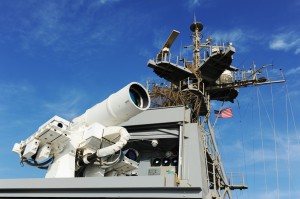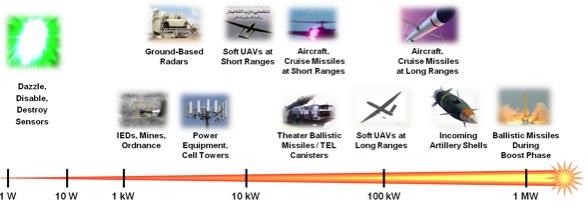CRYSTAL CITY: In three years the US military could have a prototype laser weapon blasting out 300 kilowatts of energy, a jump that could ignite a revolution in missile defense, a Lockheed Martin engineer told me today,
A 300-kw laser could kill cruise missiles. For comparison, that’s 10 times the power output of the Laser Weapons System (LaWS) currently being field-tested aboard ship in the Persian Gulf. LaWS can shoot down slow-moving drones at relatively short ranges.

Army HEL (High Energy Laser) Mobile Demonstrator
Lockheed Martin is currently on contract to upgrade the Army’s High Energy Laser Mobile Demonstrator (HEL MD) from its current 10 kilowatt output to 60 kw, with delivery sometime late next year. But Lockheed senior fellow Rob Afzal wants to go beyond 60 kw.
“We believe that system itself can go to 100,” he told reporters this afternoon at Lockheed Martin’s annual media day. “We think that, with today’s technology, fiber lasers will scale to 300, arguably beyond 300.” With future improvements in the underlying laser technologies, he said, “we think we can get well beyond 500 kw.”
Under current plans, Afzal said, “we’re dollar-limited to a 100 or 150 kw. We’re not technology-limited. And we’re probably about two to three years from being able to go to 300 [kw] if funding is supplied.”
“We can build 100-kw class systems today [that] can go onto LCS [the Navy Littoral Combat Ship],” Afzal said. (100 kw is enough to kill cruise missiles at short ranges or drones at long ranges, according to the Center for Strategic and Budgetary Assessments). “It can go onto Army trucks,” he continued. “We can go into large aircraft. We’re probably not ready for fighter aircraft today.”
At 30 to 35 percent efficiency — the current cutting edge with fiber-optic lasers — 300 kw of output would require just under a megawatt of electrical power. By contrast, older laser technologies managed about 10 percent efficiency, so that same megawatt of electricity would only get you 100 kilowatts of laser power, with the other 900 kw coming out as waste heat. You could build big lasers for experiments, but the power and cooling requirements were untenable for any tactical use.
The big difference today is small fiber lasers. Each fiber individually generates at most 10 kw, but you can combine their beams to get greater power output. Yet you can still cool each fiber individually, which prevents the overheating problems that bedeviled older lasers. (As an object grows hotter, the difficulty of getting rid of that heat increases exponentially).

The Navy’s Laser Weapons System (LaWS) aboard the USS Ponce in the Persian Gulf
The Navy’s LaWs simply sticks together six commercial cutting lasers and points them all at the same target. Lockheed’s technology goes further and combines all the lasers into a single, coherent beam, which allows much sharper focus at long ranges.
“We’re very comfortable combining hundreds of fibers,” Afzal said. The process is basically the reverse of how a prism splits a single beam of sunlight into a whole rainbow of colors: Using “spectral beam combining,” you take many lasers and combine them into one beam.
Lockheed’s already proved this beam-combining technology on a 30 kw laser the company built with its own funds, Afzal said. Now they just need to scale it up to the 60 kw the Army requires — and beyond.

Laser output required for different targets and ranges. (Courtesy Center for Strategic & Budgetary Assessments)
Major trends and takeaways from the Defense Department’s Unfunded Priority Lists
Mark Cancian and Chris Park of CSIS break down what is in this year’s unfunded priority lists and what they say about the state of the US military.



























